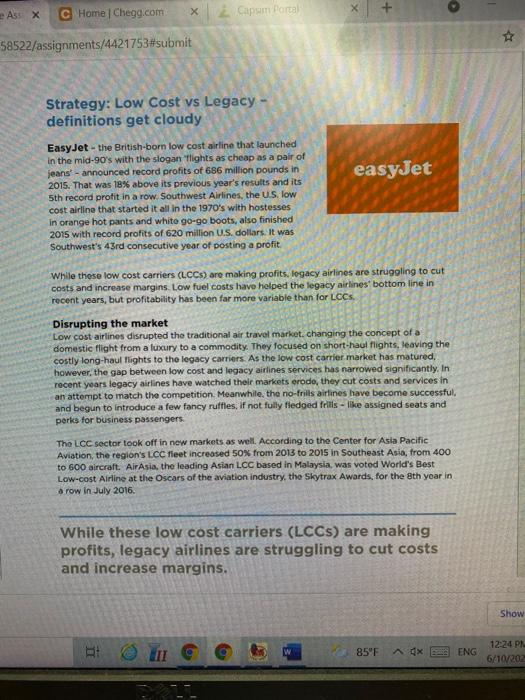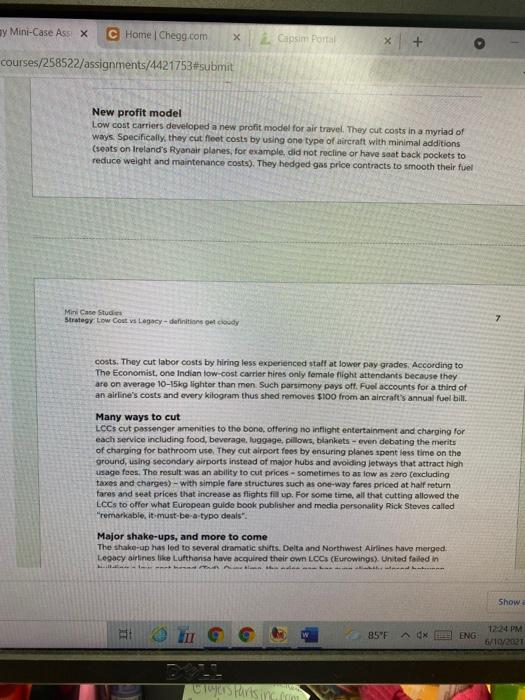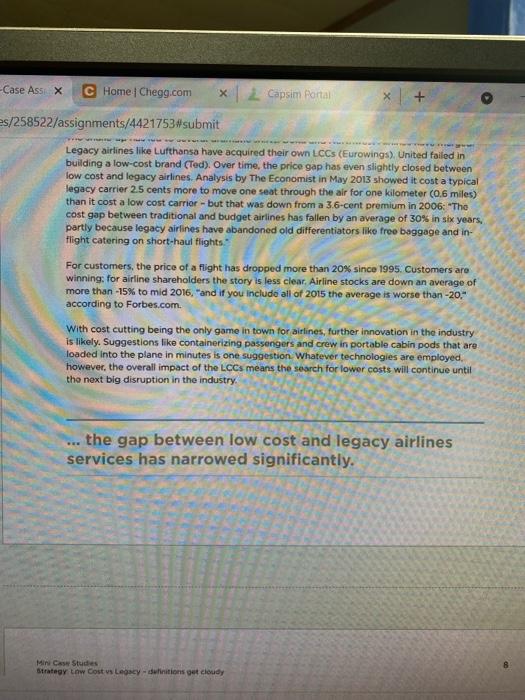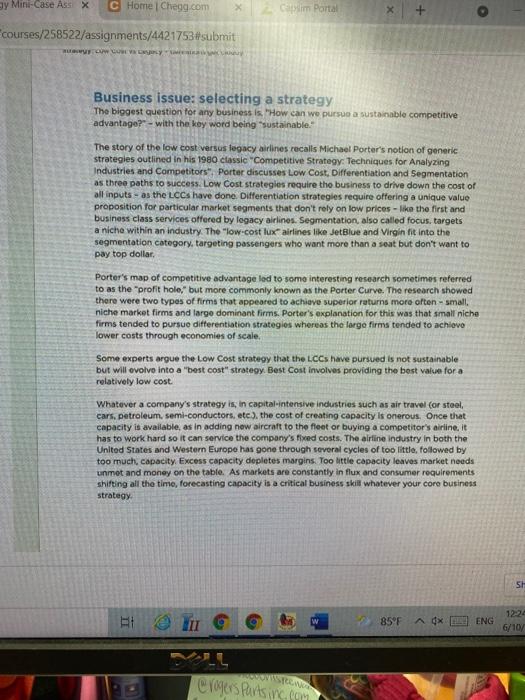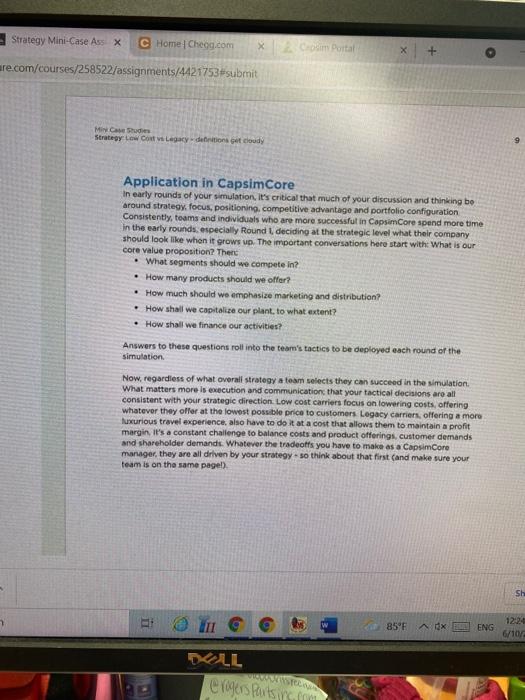i need question 8, 9 and 10 if anyone can help! Thanks in advance!

trategy Mini-Case Ass X C Home 1 Chegg.com Capo Foto * CA com/courses/258522/assignments/4421753&submit Strategy Mini-Case Assignment Due Sunday by 11:59pm Points 20 Submitting a file upload This week's mini case relates to Strategy - selecting and adhering to a strategy: how low cost carriers changed the profit model in the air travel industry, Strategy Mini Case.pdf Read the attached mini-case and respond to the following statements/questions: 1. Briefly describe the case (what the case talks about) in your own words. 2. Who are some of the stakeholders affected in the story? 3. Which stakeholders are most affected? 4. Do you know something about this issue from your own reading of the business media? 5. Can you identify some key business issues? 6. What other industries might face these problems? 7. Can you give an example of a particular company you know about that's dealing with similar issues? 8. Think about your simulation; are there any links betwe this story and the simulation? 9. Can you see parallels between the tactical decisions you make in the simulation and the deicions these managers have to make? 10. Provide any additional comments/observations you may have about the case and topic addressed. Attach a Word or PDF document as your submission for this assignment. Show all m 85 FAX ENG 12:24 PM 6/10/2021 DELL USSURES @rogers Partsinc.com e Ass X + Home | Chegg.com Caps Part 58522/assignments/4421753#submit Strategy: Low Cost vs Legacy - definitions get cloudy easyJet EasyJet - the British-born low cost airline that launched in the mid-90's with the slogan flights as cheap as a pair of jeans' - announced record profits of 686 million pounds in 2015. That was 18% above its previous year's results and its 5th record profit in a row. Southwest Airlines, the U.S. low cost airline that started it all in the 1970's with hostesses in orange hot pants and white go-go boots, also finished 2015 with record profits of 620 million US dollars. It was Southwest's 43rd consecutive year of posting a profit While those low cost carriers (LCC) are making profits, logacy airlines are struggling to cut costs and increase margins. Low fuel costs have helped the legacy airlines bottom line in recent years, but profitability has been far more variable than for LOCS. Disrupting the market Low cost airlines disrupted the traditional air travel market changing the concept of a domestic flight from a luxury to a commodity. They focused on short-haul flights, leaving the costly long-haul lights to the legacy carriers. As the low cost carrier market has matured, however, the gap between low cost and legacy airlines services has narrowed significantly. In recent years legacy airlines have watched their markets orodo, they cut costs and services in an attempt to match the competition. Meanwhile, the no-frills airlines have become successful and begun to introduce a few fancy ruffles, if not fully fledged frills-like assigned seats and perks for business passengers The LCC sector took off in new markets as well. According to the Center for Asia Pacific Aviation, the region's LCC fleet increased 50% from 2013 to 2015 in Southeast Asia, from 400 to 600 aircraft AirAsia, the leading Asian LCC based in Malaysia, was voted World's Best Low-cost Airline at the Oscars of the aviation industry, the Skytrax Awards, for the 8th year in a row in July 2016 While these low cost carriers (LCCs) are making profits, legacy airlines are struggling to cut costs and increase margins. Show 12-24 PN m W 85'F ENG 6/10/202 ay Mini-Case Ass X C Home | Chegg.com Gapsim Portal + courses/258522/assignments/4421753#submit New profit model Low cost carriers developed a new profit model for air travel. They cut costs in a myriad of ways. Specifically, they cut fleet costs by using one type of aircraft with minimal additions (seats on Ireland's Ryanair planes, for example, did not recline or have saat back pockets to reduce weight and maintenance costs). They hedged gas price contracts to smooth their fuel Mini Case Studies Strategy Low Cost vs Legacy - definitions et coudy costs. They cut labor costs by hiring less experienced staff at lower pay grades. According to The Economist, one Indian low-cost carrier hires only female flight attendants because they are on average 10-15kg lighter than men. Such parsimony pays off. Fuel accounts for a third of an airline's costs and every kilogram thus shed removes $100 from an aircraft's annual fuel bill. Many ways to cut LCC cut passenger amenities to the bone, offering no inflight entertainment and charging for each service including food, beverage, luggage, pillows, blankets - even debating the merits of charging for bathroom use, They cut airport fees by ensuring planes spent less time on the ground, using secondary airports instead of major hubs and avoiding Jetways that attract high usage fees. The result was an ability to cut prices - sometimes to as low as zero excluding taxes and charges) - with simple fare structures such as one-way fores priced at half return fares and seat prices that increase as flights fill up. For some time, all that cutting allowed the LCCs to offer what European guide book publisher and media personality Rick Steves called "remarkable, it must be a typo deals Major shake-ups, and more to come The shake-up has led to several dramatic shifts. Delta and Northwest Airlines have merged Legacy airlines lice Lufthansa have acquired their own LCC (Eurowings) Unted failed in Show 1224 PM 85 F AN ENG 6/10/2001 as parisind -Case AssiX C Home | Chegg.com Capsim Portal es/258522/assignments/44217538submit Legacy airlines like Lufthansa have acquired their own LCCS (Eurowings), United failed in building a low-cost brand Cred). Over time, the price gap has even slightly closed between low cost and legacy airlines. Analysis by The Economist in May 2013 showed it cost a typical legacy carrier 2.5 cents more to move one seat through the air for one kilometer (0.6 miles) than it cost a low cost carrior - but that was down from a 3.6-cent premium in 2006: "The cost gap between traditional and budget airlines has fallen by an average of 30% in six years, partly because legacy airlines have abandoned old differentiators like free baggage and in- flight catering on short-haul flights. For customers, the price of a flight has dropped more than 20% since 1995. Customers are winning for airline shareholders the story is less clear. Airline stocks are down an average of more than -15% to mid 2016, and if you include all of 2015 the average is worse than -20,- according to Forbes.com with cost cutting being the only game in town for airlines, further innovation in the industry is likely. Suggestions like containerizing passengers and crew in portable cabin pods that are loaded into the plane in minutes is one suggestion. Whatever technologies are employed, however, the overall impact of the LCCs means the search for lower costs will continue until the next big disruption in the industry. the gap between low cost and legacy airlines services has narrowed significantly. Mini Case Studies Strategy Low Cost vs Legacy - tinitions get cloudy gy Mini-Case Ass X C Home | Chegg.com Cam Portal X + courses/258522/assignments/4421753&submit HOW LESS Business issue: selecting a strategy The biggest question for any business is, "How can we pursue a sustainable competitive advantago? - with the key word being sustainable." The story of the low cost versus legacy airlines recalls Michael Porter's notion of generic strategies outlined in his 1980 classic "Competitive Strategy: Techniques for Analyzing Industries and Competitors". Porter discusses Low Cost, Differentiation and Segmentation as three paths to success. Low Cost strategies require the business to drive down the cost of all inputs - as the LCCs have done. Differentiation strategies require offering a unique value proposition for particular market segments that don't rely on low prices - like the first and business class services offered by legacy airlines. Segmentation also called focus, targets a niche within an industry. The "low-cost lux airlines like JetBlue and Virgin fit into the segmentation category, targeting passengers who want more than a seat but don't want to pay top dollar, Porter's map of competitive advantage led to some interesting research sometimes referred to as the "profit hole," but more commonly known as the Porter Curve. The research showed there were two types of firms that appeared to achieve superior returns more often - small. niche market firms and large dominant firms. Porter's explanation for this was that small niche firms tended to pursue differentiation strategies whereas the large firms tended to achievo lower costs through economies of scale. Some experts argue the Low Cost strategy that the LCCs have pursued is not sustainable but will evolve into a "best cost" strategy. Best Cost involves providing the best value for a relatively low cost. Whatever a company's strategy is, in capital-intensive industries such as air travel (or steel cars, petroleum, semi-conductors, etc.), the cost of creating capacity is onerous. Once that capacity is available, as in adding new aircraft to the feet or buying a competitor's airline.it has to work hard so it can service the company's fixed costs. The airline industry in both the United States and Western Europe has gone through several cycles of too little, followed by too much, capacity. Excess capacity depletes margins. Too little capacity leaves market needs unmet and money on the table. As markets are constantly in flux and consumer requirements shifting all the time, forecasting capacity is a critical business skill whatever your core business Strategy SH 12-24 85F A x L ENG 6/10 Croers Partsins.com Strategy Mini-Case Ass X C Home | Chegg.com X Com Portal are.com/courses/258522/assignments/4421753#submit Mashudies Strategy Low Cost Legacy-dations of cloudy Application in CapsimCore In early rounds of your simulation. It's critical that much of your discussion and thinking bo around strategy, focus, positioning, competitive advantage and portfolio configuration Consistently, teams and individuals who are more successful in CapsimCore spend more time in the early rounds especially Round I deciding at the strategic level what their company should look like when it grows up. The important conversations here start with: What is our core value proposition? There What segments should we compete in? How many products should we offer? How much should we emphasize marketing and distribution? How shall we capitalize our plant, to what extent? How shall we finance our activities? Answers to these questions roll into the team's tactics to be deployed each round of the simulation Now, regardless of what overall strategy a team selects they can succeed in the simulation What matters more is execution and communication that your tactical decisions are all consistent with your strategic direction. Low cost carriers focus on lowering costs, offering whatever they offer at the lowest possible price to customers. Legacy carriers, offering a more luxurious travel experience, also have to do it at a cost that allows them to maintain a profit margin, it's a constant challenge to balance costs and product offerings, customer demands and shareholder demands. Whatever the tradeoffs you have to make as a CapsimCore manager, they are all driven by your strategy. so think about that first and make sure your team is on the same page! Sh ATT w 85F Adx ENG 12:24 6/10/2 DOLL IS rogers Party.com trategy Mini-Case Ass X C Home 1 Chegg.com Capo Foto * CA com/courses/258522/assignments/4421753&submit Strategy Mini-Case Assignment Due Sunday by 11:59pm Points 20 Submitting a file upload This week's mini case relates to Strategy - selecting and adhering to a strategy: how low cost carriers changed the profit model in the air travel industry, Strategy Mini Case.pdf Read the attached mini-case and respond to the following statements/questions: 1. Briefly describe the case (what the case talks about) in your own words. 2. Who are some of the stakeholders affected in the story? 3. Which stakeholders are most affected? 4. Do you know something about this issue from your own reading of the business media? 5. Can you identify some key business issues? 6. What other industries might face these problems? 7. Can you give an example of a particular company you know about that's dealing with similar issues? 8. Think about your simulation; are there any links betwe this story and the simulation? 9. Can you see parallels between the tactical decisions you make in the simulation and the deicions these managers have to make? 10. Provide any additional comments/observations you may have about the case and topic addressed. Attach a Word or PDF document as your submission for this assignment. Show all m 85 FAX ENG 12:24 PM 6/10/2021 DELL USSURES @rogers Partsinc.com e Ass X + Home | Chegg.com Caps Part 58522/assignments/4421753#submit Strategy: Low Cost vs Legacy - definitions get cloudy easyJet EasyJet - the British-born low cost airline that launched in the mid-90's with the slogan flights as cheap as a pair of jeans' - announced record profits of 686 million pounds in 2015. That was 18% above its previous year's results and its 5th record profit in a row. Southwest Airlines, the U.S. low cost airline that started it all in the 1970's with hostesses in orange hot pants and white go-go boots, also finished 2015 with record profits of 620 million US dollars. It was Southwest's 43rd consecutive year of posting a profit While those low cost carriers (LCC) are making profits, logacy airlines are struggling to cut costs and increase margins. Low fuel costs have helped the legacy airlines bottom line in recent years, but profitability has been far more variable than for LOCS. Disrupting the market Low cost airlines disrupted the traditional air travel market changing the concept of a domestic flight from a luxury to a commodity. They focused on short-haul flights, leaving the costly long-haul lights to the legacy carriers. As the low cost carrier market has matured, however, the gap between low cost and legacy airlines services has narrowed significantly. In recent years legacy airlines have watched their markets orodo, they cut costs and services in an attempt to match the competition. Meanwhile, the no-frills airlines have become successful and begun to introduce a few fancy ruffles, if not fully fledged frills-like assigned seats and perks for business passengers The LCC sector took off in new markets as well. According to the Center for Asia Pacific Aviation, the region's LCC fleet increased 50% from 2013 to 2015 in Southeast Asia, from 400 to 600 aircraft AirAsia, the leading Asian LCC based in Malaysia, was voted World's Best Low-cost Airline at the Oscars of the aviation industry, the Skytrax Awards, for the 8th year in a row in July 2016 While these low cost carriers (LCCs) are making profits, legacy airlines are struggling to cut costs and increase margins. Show 12-24 PN m W 85'F ENG 6/10/202 ay Mini-Case Ass X C Home | Chegg.com Gapsim Portal + courses/258522/assignments/4421753#submit New profit model Low cost carriers developed a new profit model for air travel. They cut costs in a myriad of ways. Specifically, they cut fleet costs by using one type of aircraft with minimal additions (seats on Ireland's Ryanair planes, for example, did not recline or have saat back pockets to reduce weight and maintenance costs). They hedged gas price contracts to smooth their fuel Mini Case Studies Strategy Low Cost vs Legacy - definitions et coudy costs. They cut labor costs by hiring less experienced staff at lower pay grades. According to The Economist, one Indian low-cost carrier hires only female flight attendants because they are on average 10-15kg lighter than men. Such parsimony pays off. Fuel accounts for a third of an airline's costs and every kilogram thus shed removes $100 from an aircraft's annual fuel bill. Many ways to cut LCC cut passenger amenities to the bone, offering no inflight entertainment and charging for each service including food, beverage, luggage, pillows, blankets - even debating the merits of charging for bathroom use, They cut airport fees by ensuring planes spent less time on the ground, using secondary airports instead of major hubs and avoiding Jetways that attract high usage fees. The result was an ability to cut prices - sometimes to as low as zero excluding taxes and charges) - with simple fare structures such as one-way fores priced at half return fares and seat prices that increase as flights fill up. For some time, all that cutting allowed the LCCs to offer what European guide book publisher and media personality Rick Steves called "remarkable, it must be a typo deals Major shake-ups, and more to come The shake-up has led to several dramatic shifts. Delta and Northwest Airlines have merged Legacy airlines lice Lufthansa have acquired their own LCC (Eurowings) Unted failed in Show 1224 PM 85 F AN ENG 6/10/2001 as parisind -Case AssiX C Home | Chegg.com Capsim Portal es/258522/assignments/44217538submit Legacy airlines like Lufthansa have acquired their own LCCS (Eurowings), United failed in building a low-cost brand Cred). Over time, the price gap has even slightly closed between low cost and legacy airlines. Analysis by The Economist in May 2013 showed it cost a typical legacy carrier 2.5 cents more to move one seat through the air for one kilometer (0.6 miles) than it cost a low cost carrior - but that was down from a 3.6-cent premium in 2006: "The cost gap between traditional and budget airlines has fallen by an average of 30% in six years, partly because legacy airlines have abandoned old differentiators like free baggage and in- flight catering on short-haul flights. For customers, the price of a flight has dropped more than 20% since 1995. Customers are winning for airline shareholders the story is less clear. Airline stocks are down an average of more than -15% to mid 2016, and if you include all of 2015 the average is worse than -20,- according to Forbes.com with cost cutting being the only game in town for airlines, further innovation in the industry is likely. Suggestions like containerizing passengers and crew in portable cabin pods that are loaded into the plane in minutes is one suggestion. Whatever technologies are employed, however, the overall impact of the LCCs means the search for lower costs will continue until the next big disruption in the industry. the gap between low cost and legacy airlines services has narrowed significantly. Mini Case Studies Strategy Low Cost vs Legacy - tinitions get cloudy gy Mini-Case Ass X C Home | Chegg.com Cam Portal X + courses/258522/assignments/4421753&submit HOW LESS Business issue: selecting a strategy The biggest question for any business is, "How can we pursue a sustainable competitive advantago? - with the key word being sustainable." The story of the low cost versus legacy airlines recalls Michael Porter's notion of generic strategies outlined in his 1980 classic "Competitive Strategy: Techniques for Analyzing Industries and Competitors". Porter discusses Low Cost, Differentiation and Segmentation as three paths to success. Low Cost strategies require the business to drive down the cost of all inputs - as the LCCs have done. Differentiation strategies require offering a unique value proposition for particular market segments that don't rely on low prices - like the first and business class services offered by legacy airlines. Segmentation also called focus, targets a niche within an industry. The "low-cost lux airlines like JetBlue and Virgin fit into the segmentation category, targeting passengers who want more than a seat but don't want to pay top dollar, Porter's map of competitive advantage led to some interesting research sometimes referred to as the "profit hole," but more commonly known as the Porter Curve. The research showed there were two types of firms that appeared to achieve superior returns more often - small. niche market firms and large dominant firms. Porter's explanation for this was that small niche firms tended to pursue differentiation strategies whereas the large firms tended to achievo lower costs through economies of scale. Some experts argue the Low Cost strategy that the LCCs have pursued is not sustainable but will evolve into a "best cost" strategy. Best Cost involves providing the best value for a relatively low cost. Whatever a company's strategy is, in capital-intensive industries such as air travel (or steel cars, petroleum, semi-conductors, etc.), the cost of creating capacity is onerous. Once that capacity is available, as in adding new aircraft to the feet or buying a competitor's airline.it has to work hard so it can service the company's fixed costs. The airline industry in both the United States and Western Europe has gone through several cycles of too little, followed by too much, capacity. Excess capacity depletes margins. Too little capacity leaves market needs unmet and money on the table. As markets are constantly in flux and consumer requirements shifting all the time, forecasting capacity is a critical business skill whatever your core business Strategy SH 12-24 85F A x L ENG 6/10 Croers Partsins.com Strategy Mini-Case Ass X C Home | Chegg.com X Com Portal are.com/courses/258522/assignments/4421753#submit Mashudies Strategy Low Cost Legacy-dations of cloudy Application in CapsimCore In early rounds of your simulation. It's critical that much of your discussion and thinking bo around strategy, focus, positioning, competitive advantage and portfolio configuration Consistently, teams and individuals who are more successful in CapsimCore spend more time in the early rounds especially Round I deciding at the strategic level what their company should look like when it grows up. The important conversations here start with: What is our core value proposition? There What segments should we compete in? How many products should we offer? How much should we emphasize marketing and distribution? How shall we capitalize our plant, to what extent? How shall we finance our activities? Answers to these questions roll into the team's tactics to be deployed each round of the simulation Now, regardless of what overall strategy a team selects they can succeed in the simulation What matters more is execution and communication that your tactical decisions are all consistent with your strategic direction. Low cost carriers focus on lowering costs, offering whatever they offer at the lowest possible price to customers. Legacy carriers, offering a more luxurious travel experience, also have to do it at a cost that allows them to maintain a profit margin, it's a constant challenge to balance costs and product offerings, customer demands and shareholder demands. Whatever the tradeoffs you have to make as a CapsimCore manager, they are all driven by your strategy. so think about that first and make sure your team is on the same page! Sh ATT w 85F Adx ENG 12:24 6/10/2 DOLL IS rogers Party.com


